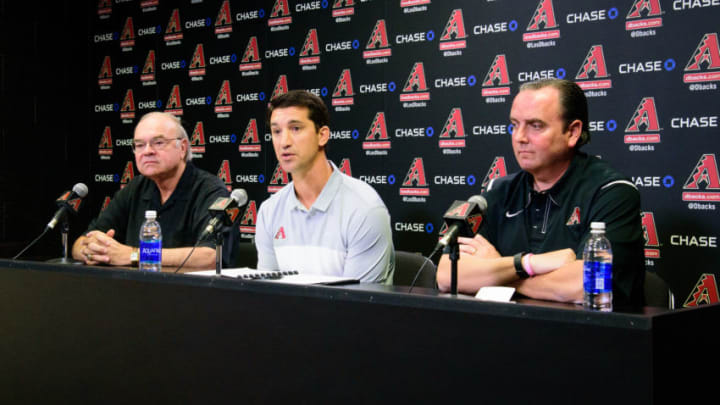Let’s take a look at the front office structure of the Arizona Diamondbacks, with a particular focus on President Derrick Hall and GM Mike Hazen.
- Arizona Diamondbacks
- Managing General Partner: Ken Kendrick
- President: Derrick Hall
- Executive VP and General Manager: Mike Hazen
A member of the D-Backs’ ownership group since the franchise’s creation, Kendrick was named managing general partner in 2004. Generally viewed as a hands-off owner, late in the 2006 season he named Hall the team’s president, putting him in the controlling position.
More from Call to the Pen
- Philadelphia Phillies, ready for a stretch run, bomb St. Louis Cardinals
- Philadelphia Phillies: The 4 players on the franchise’s Mount Rushmore
- Boston Red Sox fans should be upset over Mookie Betts’ comment
- Analyzing the Boston Red Sox trade for Dave Henderson and Spike Owen
- 2023 MLB postseason likely to have a strange look without Yankees, Red Sox, Cardinals
Hall, 50, has during his tenure appointed four general managers: Jerry DiPoto (2010), Kevin Towers (2011), Dave Stewart (2015) and the incumbent, Mike Hazen, 2017. Including Josh Byrnes, the incumbent GM when Hall was hired, that translates to an average tenure under Hall of just 2.6 seasons, and it cements Hall’s place as the focal point of policy in Phoenix.
Who is Hall? Following his 1991 graduation from Arizona State, he interspersed non-baseball work with stints on the staff of the Los Angeles Dodgers and in media related to coverage of the Dodgers. He joined the Diamondbacks in 2005 as senior vice president of communications following a brief stint as an executive with a Fortune 500 company, and a little more than a year later was elevated to the team presidency.
Hall hired Hazen as general manager following the 2016 season, replacing Stewart.
Hazen, who is 44, came to the Arizona Diamondbacks from the Boston Red Sox, where he was a general manager under team president Dave Dombrowski. A Princeton grad, Hazen started out as an intern with the Cleveland Indians and worked through various full-time positions before joining the Red Sox as director of player development.
When Ben Cherington was named general manager following the 2011 season, he appointed Hazen his top assistant. Cherington left following the 2015 season, and Dombrowski appointed Hazen general manager, an office he held until being lured away by Hall following the 2016 season.
Hall and Hazen, then, form what amounts to a controlling duo, with the principal power held by Hall. That, in turn, raises the question: How have they done?
The best way to answer that is to look at some of the measurables. Forbes recently put the Arizona Diamondbacks franchise value at $1.29 billion for 2019, about 6.6 percent higher than the $1.21 estimated valuation of 2018. Team revenues rose 8.6 percent between 2016 and 2018, from $253 million to $275 million, the $285 million ranking 20th among MLB’s 30 teams.
More from Arizona Diamondbacks
- Can we expect late-season runs for the Cincinnati Reds and Arizona Diamondbacks?
- MLB rumors: Arizona Diamondbacks taking less aggressive approach at MLB trade deadline
- Trade deadline: NL West for sale, plus Dodgers, Giants, Diamondbacks wish list
- Arizona Diamondbacks: Are they a pretender or contender for the NL West and more?
- Mike Hazen’s impact on the Arizona Diamondbacks: An interim grade
Hall and Hazen have accelerated spending, at least by comparison with previous seasons. Since Hazen’s arrival, the Diamondbacks have averaged a $116.033 million payroll, topping out at $131.465 million in 2018. Their projected 2020 payroll could wind up as high as $137 million. If so, that would be a franchise spending record.
In terms of talent acquisition, the numbers are not as favorable. Since Hazen came on board prior to the 2017 season, Arizona’s talent base has changed by an average of -1.1 games per season based on the net change in Wins Above Average.* Easily the duo’s most publicized moves were the departures of the team’s two stars, Paul Goldschmidt and Zack Greinke.
Their most productive acquisition? It was probably a subtle one, the November 2016 trade with Seattle that brought Arizona infielder-outfielder Ketel Marte and pitcher Taijuan Walker for Jean Segura and two other players. Marte in 2019 developed into a star.
They did spring this current winter for free-agent pitcher Madison Bumgarner, who got a five-year, $85 million deal. Aside from that, most of the multi-year moves made by Hall-Hazen have been second-tier, such as the re-signing of David Peralta to a three-year, $22 million deal and Eduardo Escobar to a three-year $21 million contract in 2019. Since the Greinke signing, the Diamondbacks have not been aggressive free agent players.
Going forward, there is every reason to believe that Hall has the full confidence of Kendrick. Hazen’s status under Hall is another issue. As GM, he has yet to deliver a positive short-term impact on the Arizona Diamondbacks fortunes. That plus Hall’s history of running through GMs every few years suggests that 2020 is a pivotal time for Hazen, now entering his fourth season. If he is still the general manager one year from now, he will break the record for a Derrick Hall hire.
*This calculation is obtained by determining the net impact of all player transactions on team performance for the season(s) in question. Wins Above Average is a zero-based offshoot of Wins Above Replacement; thus, the final figure suggests the degree of positive or negative movement in the standings that is attributable to front office moves.
